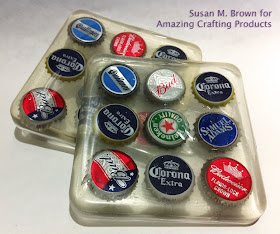And what does this have to do with
Amazing Crafting Products by Alumilite Corporation? Well, I really liked the dragonfly I created, and knew it would make an AMAZING cast resin piece.
Supplies:
Amazing Mold Putty
Amazing Clear Cast Resin
1 illustration board ATC
Waxed Bookbinding thread
A dragonfly knot (Google 'dragonfly knot'; you'll find all sorts of how-to's)
Krylon Pale Gold Leafing Pen
Pearl Ex Powders-Interference Red and Interference Blue
Golden Fiber Paste and Heavy Gel medium
Miracle Tape sheet
A photo of a Koi pond
The Dragonfly Knot
When I knotted my dragonfly, I used waxed bookbinding thread because it required two threads, and the tacky surface made it easier to keep them together. It also resulted in a solidly knotted piece that was perfect for casting.
I needed something to fill in the wings, however, and I had just made a *fiber paste skin, so I used some left-over pieces.
*Fiber paste is an acrylic paste medium that you can spread on a non-stick sheet to create a textured paper-like 'skin'.
The Molds
Amazing Mold Putty comes in two parts, a white putty and a yellow. You mix equal amounts of both, rolling them into a ball to remove creases, until the whole piece turns yellow. Then you wrap it around the object. The whole process takes 10-15 minutes.
Using this process, I created a mold for the Dragonfly knot and I also created a second mold using an illustration board ATC.
I wanted the transparency of a dragonfly's wings so I decided to use the
Amazing Clear Cast Resin. A tip-- wear gloves. You can get the resin off with rubbing alcohol, but it's easier not to get the stickum on you in the first place (I speak from experience, lol).
To add a touch of color, I sprinkled some Pearl Ex powder in the mold, where the wings would be. I chose interference colors, which are very transparent and which change color in the light.
The Casting
As with the
Amazing Mold Putty, you mix two products--liquids this time. You pour equal amounts of Parts A and B into measuring cups and then pour the two amounts together. Be sure to read the instructions to learn how to eliminate bubbles and pour the resin into the mold. There is a link at the bottom of this post that will take you to videos and detailed written instructions on both the mold and casting processes.
Both my knot and ATC molds were fairly shallow so there was some overflow, but it is easy to trim away the excess.
Putting it together
Although I wanted transparency, I also wanted more color. After thinking about it, I decided to use a Krylon Pale Gold Leafing pen. I skimmed the ink over the Dragonfly's body to pick out detail, while still leaving transparency. I also picked out the edges of the wings.
I chose a photo I had recently taken of a Koi pond. It wasn't a very good photo but that was okay. It had a watery look, and I wanted to keep the focus on the dragonfly. I printed the photo on printer paper and cut it to ATC size. Using Miracle tape, I stuck the photo, facing up, on the bottom of my resin ATC so it would show through. Using the same interference paint that was on the dragonfly's wings, I added a few ripples to the top of the ATC.
I decided to use Golden Heavy Gel Medium to attach the dragonfly because of the weight.
I felt the ATC needed something else, but I wanted to keep it simple. I had a piece of overflow that was a nice droplet shape. I added a touch of the interference paint and stuck it on the ATC.
Voilà! I had a dragonfly skimming across a pond!
I've added my ATC to the
Anything But a Card challenge. Been making ATCs? Consider joining in on the fun!
For more of my work in
Amazing Mold Putty, zentangle-inspired art, and daily links to tangles, tutorials, and giveaways please visit my "
Life Imitates Doodles" blog. ~ Sandra Strait
.................................
__________________________________________
.................................
For both written and video instructions showing how to create
Amazing Mold Putty molds, and cast resin object, please visit the
Amazing Crafting Products library.




















































